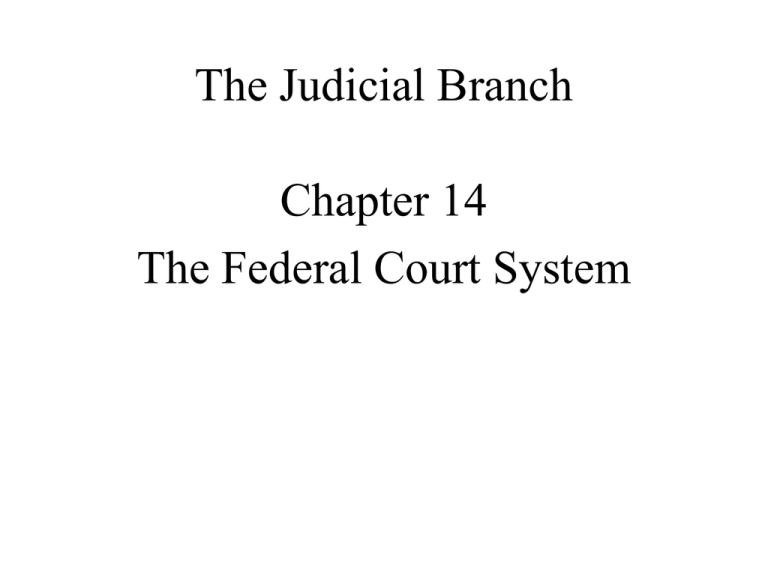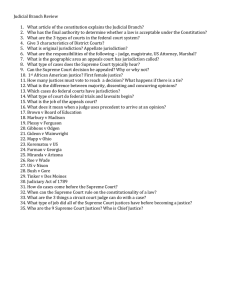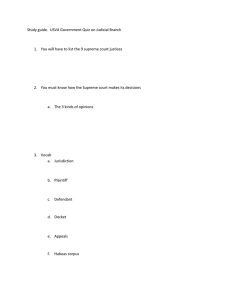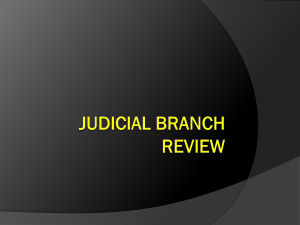The Judicial Branch Chapter 14 The Federal Court System
advertisement

The Judicial Branch Chapter 14 The Federal Court System The American Court Structure The U.S. has a dual court system. dual court One system of state and local courts and another system of federal courts. The American Court Structure The court’s jurisdiction is set by law and limited by territory and type of case. Jurisdiction: The authority of a court to hear and decide cases. Original jurisdiction – hear the case first (criminal or civil) Appellate jurisdiction – review cases from lower courts involving questions or law or procedure The Federal Courts The authority for the federal court system is in the Constitution. The system, and its jurisdiction & size is created/monitored by Congress and includes: • The Supreme Court • The federal Courts of Appeals (circuit courts) • The federal District Courts United States District Courts • Trials in federal district court are usually heard by a judge & jury. • Both civil & criminal cases can be filed • Federal criminal cases involve: Bank robbery Identity Theft Counterfeiting Mail fraud Kidnapping Civil rights abuses Maritime & Admiral law Circuit Courts of Appeals A party that loses a case in district court may appeal to a Federal Circuit Court of Appeals, or in rare cases, directly to the U.S. Supreme Court. When appealing to the S.C., a party petitions the Court for a writ of certiorari or “cert.” The S.C. then requests the transcripts & documents from all previous trials. Circuit Courts of Appeals • 13 Circuit courts of appeals review a case for procedural errors & interpretations of law, not fact (11 districts + D.C. + federal circuit) • Normally, three judges sit as a panel to hear cases. Jury trials are not allowed. • “En banc” cases involve all judges hearing a case together. Most often, it is to review a previous decision made by the panel. • “Per curiam” decisions are those that are not signed by individual judges. • Virginia is in the Fourth Circuit with WV, NC, SC, & MD - located in Richmond, VA The United States Supreme Court • Final arbiter of federal laws, Constitution & treaties (appellate jurisdiction) • The court may hear cases: Appealed from federal courts of appeal, directly from district courts or from the high court of a state, if claims under federal law or the Constitution are involved The court has original jurisdiction for cases involving state v. state, fed. gov. v. state or foreign diplomats/country The United States Supreme Court The U.S. Supreme Court is composed of: •A chief justice & eight associate justices (since 1869 Circuit Judges Act) •Justices have life tenure & are appointed by the president and affirmed by Senate after hearings with Judiciary Committee. •Life tenure to insulate Justices from political arena of elections & from undue influence of those who might reappoint them. •Justices can be impeached by Congress. The United States Supreme Court • At least four justices must vote to hear the case – rule of four (law clerks play a role here) • If accepted, S.C. requests writ of certiorari ordering lower court to send up the case records • In general, they choose cases that have broad national significance, involve civil rights or liberties, or appeal to ideology of justices • U.S. solicitor general represents U.S. in S.C. & 70-80% of the fed. gov. cases are accepted • Cases set precedents for law The United States Supreme Court When the court decides a case, it can: • Affirm the decision of lower court -“let it stand” – stare decisis – this is a measure of policy-making (restraint – stare decisis v. activism – if overturning) • Modify the decision of the lower court, without totally reversing it (multiple issues are involved) • Reverse the decision of the lower court, requiring no further court action • Reverse the decision of the lower court & remand the case to the court of original jurisdiction, for either retrial or resentencing Politics & The U.S. Supreme Court •Litmus Test: Most presidents seek to appoint justices who share their policy preferences, taking into account whether they are strict or loose constructionists of the Constitution based on previous judicial experience & actions; Senate Judiciary Committee conducts litmus tests during appointment process too •Most presidents recognize Senatorial Courtesy – unwritten custom whereby president consults with the senior Senator of her/his party regarding an appointment to district court in that state •Designed to be more independent of public opinion, but rulings rarely deviate far from prevalent opinion •Appointed for life, control their docket, no demotions, appointed, not elected & public has limited access to Court proceedings •Rely on public officials to execute decisions, appointment & confirmation tend to be public today, impeachment, Congress can change jurisdiction & #, concern for reputation, credibility, etc. Judicial Activism v. Restraint Judicial decision making is based on the Constitution & the reading of various statutes & precedents. Determining what the framers meant often appears to be based on an individual jurist’s philosophy. Activism v. restraint debate: • Advocates of restraint argue that the courts should be less involved in policymaking, they are appointed, not elected, hence other branches or states should be policymakers. (cite Roe v. Wade) • Advocates of activism argue that judges should use their powers broadly, especially in the areas of equality & personal liberty, interpreting the Constitution loosely. (cite Brown v. Board of Ed.)







